Role of Titanium Dioxide-Immobilized PES Beads in a Combined Water Treatment System of Tubular Alumina Microfiltration and PES Beads
Abstract
:1. Introduction
2. Materials and Methods
3. Results and Discussion
3.1. Role of TiO2-Immobilized PES Beads on Membrane Fouling and Treatment Effectiveness with Intermittent Air Backwashing
3.2. Role of TiO2-Immobilized PES Beads on Membrane Fouling and Treatment Effectiveness with Water Backwashing
4. Conclusions
- (1)
- For air backwashing, the resistances of membrane fouling (Rf) sustained the bottom data at 50 g/L PES beads up until 45 min of the process, and suddenly increased at 60 min; however, it was the bottom at 30 g/L of the PES beads after 90 min. Too many TiO2-immobilized PES beads could be coated rapidly by the humic acid and kaolin up until 60 min of the process, and then did not have the role of TiO2 anymore after 60 min. Finally, the optimal PES bead condition could be 30 g/L for long time during the process. In our former work [35] regarding the combined water treatment system of seven channels of ceramic MF and pure PP beads with air backwashing, the Rf obtained the bottom at 50 g/L PP beads. This means that more PP beads could repress the membrane fouling the more remarkably in this combined water treatment system. This also verified that the best media condition was dependent on the material of the beads in the combined water treatment system with air backwashing.
- (2)
- The dimensionless treated water flux (J180/J0) after the 3 h process at 20 and 30 g/L of the PES beads obtained the peak; nevertheless, the total treated water volume (VT) had the peak at 40 g/L of the PES beads. Finally, the best PES bead concentration could be 40 g/L in the combined water treatment system with air backwashing. In the former research [35], the VT was the maximum at 30 and 50 g/L of the PP beads. This means that the best condition of PP beads could be 30 g/L. The best condition of PES and PP beads did not agree with each other, owing to different material beads.
- (3)
- For water backwashing, the Rf,180 obtained the bottom at 40 g/L PES beads. Finally, the 40 g/L PES beads could be the best condition. It was a little dissimilar tendency, when compared to the optimal PES beads with air backwashing could be 30 g/L for long process, owing to a different backwashing medium. In our former results [34] regarding the combined water treatment system of seven channels of ceramic MF and pure PP beads, the Rf was at the bottom at 5 g/L of the PP beads during the 3 h process. This verified that the best PP beads’ concentration could be 5 g/L to reduce the membrane fouling and a lot of treated water volume.
- (4)
- The peak VT was 2.67 L at 40 g/L PES beads because the treated water flux could be maintained extremely throughout the 3 h process. The maximum VT 7.06 L at air backwashing was 2.64 times higher than the peak VT 2.67 L at water backwashing. This means that the air backwashing system could acquire more treated water than the water backwashing system.
- (5)
- The effectiveness of turbidity for air backwashing obtained an increasing tendency when increasing PES beads; however, for water backwashing, it obtained almost constant, independent of PES beads. The effectiveness of DOM for air backwashing increased dramatically when increasing the beads; however, for water backwashing, it increased slowly and obtained a maximum at 40 g/L PES beads.
Author Contributions
Funding
Institutional Review Board Statement
Informed Consent Statement
Data Availability Statement
Conflicts of Interest
References
- Meng, F.G.; Chae, S.R.; Drews, A.; Kraume, M.; Shin, H.S.; Yang, F. Recent advances in membrane bioreactors (MBRs): Membrane fouling and membrane material. Water Res. 2009, 43, 1489–1512. [Google Scholar] [CrossRef]
- Liu, C.X.; Zhang, D.R.; He, Y.; Zhao, X.S.; Bai, R. Modification of membrane surface for anti-biofouling performance: Effect of anti-adhesion and anti-bacterial approaches. J. Membr. Sci. 2010, 346, 121–130. [Google Scholar] [CrossRef]
- Cui, X.; Choo, K.-H. Natural Organic Matter Removal and Fouling Control in Low-Pressure Membrane Filtration for Water Treatment. Environ. Eng. Res. 2014, 19, 1–8. [Google Scholar] [CrossRef]
- Manamperuma, L.D.; Vik, E.A.; Benjamin, M.; Cai, Z.; Skjefstad, J. Effects of a novel adsorbent on membrane fouling by natural organic matter in drinking water treatment. Membranes 2019, 9, 151. [Google Scholar] [CrossRef]
- Nikos, S.L.; Despina, R.; Eleftheria, K. Disinfection of spring water and secondary treated municipal wastewater by TiO2 photocatalysis. Desalination 2010, 250, 351–355. [Google Scholar] [CrossRef]
- Li, F.; Lu, C.; Xu, B.; Cheng, L.-Y. Photocatalytic degradation of rhodamine B under visible light irradiation by TiO2 doped layered zirconium phosphates. J. Nanosci. Nanotech. 2020, 20, 1697–1703. [Google Scholar] [CrossRef]
- Ji, L.; Li, J.; Lei, J.; Ren, Y.; Zhou, S. Preparation and characterization of Cu2+/ZnO/TiO2 nanocomposites for the treatment of typical benzene series in oilfield produced water. Catal. Commun. 2023, 174, 106572. [Google Scholar] [CrossRef]
- Lei, B.; Robertson, N. TiO2 mesocrystals: Immobilisation, surface fluorination and application in photocatalytic water treatment. Appl. Surf. Sci. 2023, 616, 156487. [Google Scholar] [CrossRef]
- Matoh, L.; Žener, B.; Kovačić, M.; Kušić, H.; Arčon, I.; Levstek, M.; Štangar, U.L. Photocatalytic sol-gel/P25 TiO2 coatings for water treatment: Degradation of 7 selected pharmaceuticals. Ceram. Int. 2023, 49, 24395–24406. [Google Scholar] [CrossRef]
- Gao, Y.; Zhang, Y.; Dudek, M.; Qin, J.; Øye, G.; Østerhus, S.W. A multivariate study of backpulsing for membrane fouling mitigation in produced water treatment. J. Environ. Chem. Eng. 2020, 2020, 104839. [Google Scholar] [CrossRef]
- Cakl, J.; Bauer, I.; Dolček, P.; Mikulášek, P. Effects of backflushing conditions on permeate flux in membrane crossflow microfiltration of oil emulsion. Desalination 2000, 127, 189–198. [Google Scholar] [CrossRef]
- Abadi, S.R.H.; Sebzari, M.R.; Hemati, M.; Rekabdar, F.; Mohammadi, T. Ceramic membrane performance in microfiltration of oily wastewater. Desalination 2011, 265, 222–228. [Google Scholar] [CrossRef]
- Tian, J.; Wu, C.; Yu, H.; Gao, S.; Li, G.; Cui, F.; Qu, F. Applying ultraviolet/persulfate (UV/PS) pre-oxidation for controlling ultrafiltration membrane fouling by natural organic matter (NOM) in surface water. Water Res. 2018, 132, 190–199. [Google Scholar] [CrossRef] [PubMed]
- Abdullaha, R.R.; Shabeeba, K.M.; Alzubaydi, A.B.; Figoli, A.; Criscuoli, A.; Drioli, E.; Alsalhy, Q.F. Characterization of the efficiency of photo-catalytic ultrafiltation PES membrane modified with tungsten oxide in the removal of tinzaparin sodium. Eng. Technol. J. 2022, 40, 1633–1641. [Google Scholar] [CrossRef]
- Kusworo, T.D.; Utomo, D.P. Performance evaluation of double stage process using nano hybrid PES/SiO2-PES membrane and PES/ZnO-PES membranes for oily waste water treatment to clean water. J. Environ. Chem. Eng. 2017, 5, 6077–6086. [Google Scholar] [CrossRef]
- Szymański, K.; Morawski, A.W.; Mozia, S. Surface water treatment in hybrid systems coupling advanced oxidation processes and ultrafiltration using ceramic membrane. Desalin. Water Treat. 2017, 64, 302–306. [Google Scholar] [CrossRef]
- Hofs, B.; Ogier, J.; Vries, D.; Beerendonk, E.F.; Cornelissen, E.R. Comparison of ceramic and polymeric membrane permeability and fouling using surface water. Sep. Purif. Technol. 2011, 79, 365–374. [Google Scholar] [CrossRef]
- Chen, M.; Heijman, S.G.J.; Rietveld, L.C. State-of-the-art ceramic membranes for oily wastewater treatment: Modification and application. Membranes 2021, 11, 888. [Google Scholar] [CrossRef]
- Liu, P.; Liu, J.; Wang, Z.; Jiao, Y.; Bie, A.; Xia, J. Application of inorganic ceramic membrane in treatment of emulsion wastewater. Oxidat. Commun. 2016, 39, 2753–2757. [Google Scholar]
- Zhang, X.; Fan, L.; Roddick, F.A. Influence of the characteristics of soluble algal organic matter released from Microcystis aeruginosa on the fouling of a ceramic microfiltration membrane. J. Membr. Sci. 2013, 425, 23–29. [Google Scholar] [CrossRef]
- Zhang, X.; Fan, L.; Roddick, F.A. Impact of the interaction between aquatic humic substances and algal organic matter on the fouling of a ceramic microfiltration membrane. Membranes 2018, 8, 7. [Google Scholar] [CrossRef] [PubMed]
- Rocco, M.J.; Hafuka, A.; Tsuchiya, T.; Kimura, K. Efficient recovery of organic matter from municipal wastewater by a high-rate membrane bioreactor equipped with flat-sheet ceramic membranes. Membranes 2023, 13, 300. [Google Scholar] [CrossRef] [PubMed]
- Benito, A.; Penadés, A.; Lliberia, J.L.; Gonzalez-Olmos, R. Degradation pathways of aniline in aqueous solutions during electro-oxidation with BDD electrodes and UV/H2O2 treatment. Chemosphere 2017, 166, 230–237. [Google Scholar] [CrossRef] [PubMed]
- Khuzwayo, Z.; Chirwa, E.M.N. Analysis of catalyst photo-oxidation selectivity in the degradation of polyorganochlorinated pollutants in batch systems using UV and UV/TiO2. S. Afr. J. Chem. Eng. 2017, 23, 17–25. [Google Scholar]
- Milelli, D.; Lemont, F.; Ruffel, L.; Barral, T.; Marchand, M. Thermo- and photo-oxidation reaction scheme in a treatment system using submerged plasma. Chem. Eng. J. 2017, 317, 1083–1091. [Google Scholar] [CrossRef]
- Morgan, A.; Cocca, M.; Vega, K.; Fleischer, A.; Gupta, S.K.; Mehan, M.; Takacs, G.A. Vacuum UV photo-oxidation of poly(ethylene terephthalate). J. Adhes. Sci. Technol. 2017, 31, 2542–2554. [Google Scholar] [CrossRef]
- Semitsoglou-Tsiapou, S.; Templeton, M.R.; Graham, N.J.D.; Hernández Leal, L.; Martijn, B.J.; Royce, A.; Kruithof, J.C. Low pressure UV/H2O2 treatment for the degradation of the pesticides metaldehyde, clopyralid and mecoprop—Kinetics and reaction product formation. Water Res. 2016, 91, 285–294. [Google Scholar] [CrossRef]
- Li, A.; Zhao, X.; Liu, H.; Qu, J. Characteristic transformation of humic acid during photoelectrocatalysis process and its subsequent disinfection byproduct formation potential. Water Res. 2011, 45, 6131–6140. [Google Scholar] [CrossRef]
- Amarsanaa, B.; Park, J.Y. Effect of water backwashing and PP beads in hybrid water treatment of multi-channel alumina MF and photocatalyst-coated PP beads. Desalin. Water Treat. 2015, 54, 1457–1469. [Google Scholar] [CrossRef]
- Gang, G.L.; Park, J.Y. Hybrid water treatment process of tubular carbon fiber ultrafiltration and photocatalyst-coated PP beads: Treatment mechanisms and effects of water backwashing time. Desalin. Water Treat. 2016, 57, 7721–7732. [Google Scholar] [CrossRef]
- Park, Y.; Park, J.Y. Roles of adsorption and photo-oxidation in hybrid water treatment process of tubular carbon fiber ultrafiltration and PP beads with UV irradiation and water back-flushing. Desalin. Water Treat. 2017, 61, 20–28. [Google Scholar] [CrossRef]
- Bounomenna, M.G.; Figoli, A.; Spezzano, I.; Davoli, M.; Drioli, E. New PVDF microcapsules for application in catalysis. Appl. Catal. B Environ. 2008, 80, 185. [Google Scholar] [CrossRef]
- Figoli, A.; Luca, G.D.; Longavita, E.; Drioli, E. PEEKWC capsules prepared by phase inversion technique: A morphological and dimensional study. Sep. Sci. Technol. 2007, 42, 2809–2827. [Google Scholar] [CrossRef]
- Hwang, S.; Lee, Y.; Park, J.Y. The role of humic acid, PP beads, and pH with water backwashing in a hybrid water treatment of multichannel alumina microfiltration and PP beads. Membranes 2020, 10, 3. [Google Scholar] [CrossRef] [PubMed]
- Park, S.; Kim, D.; Park, J.Y. The role of adsorption, photo-oxidation, and PP beads with air backwashing in hybrid water treatment of multichannel alumina MF and PP beads. Membranes 2020, 10, 28. [Google Scholar] [CrossRef]
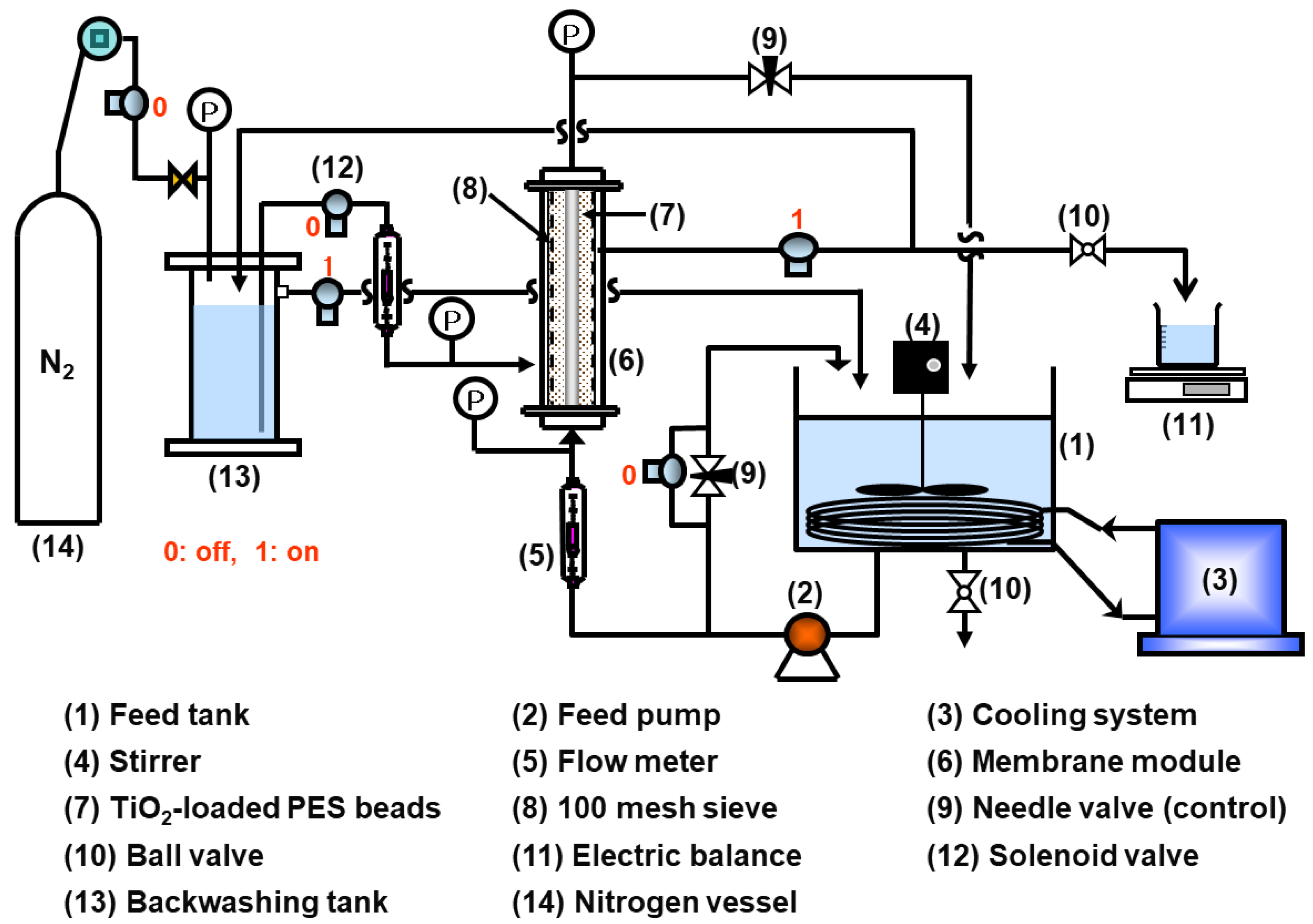

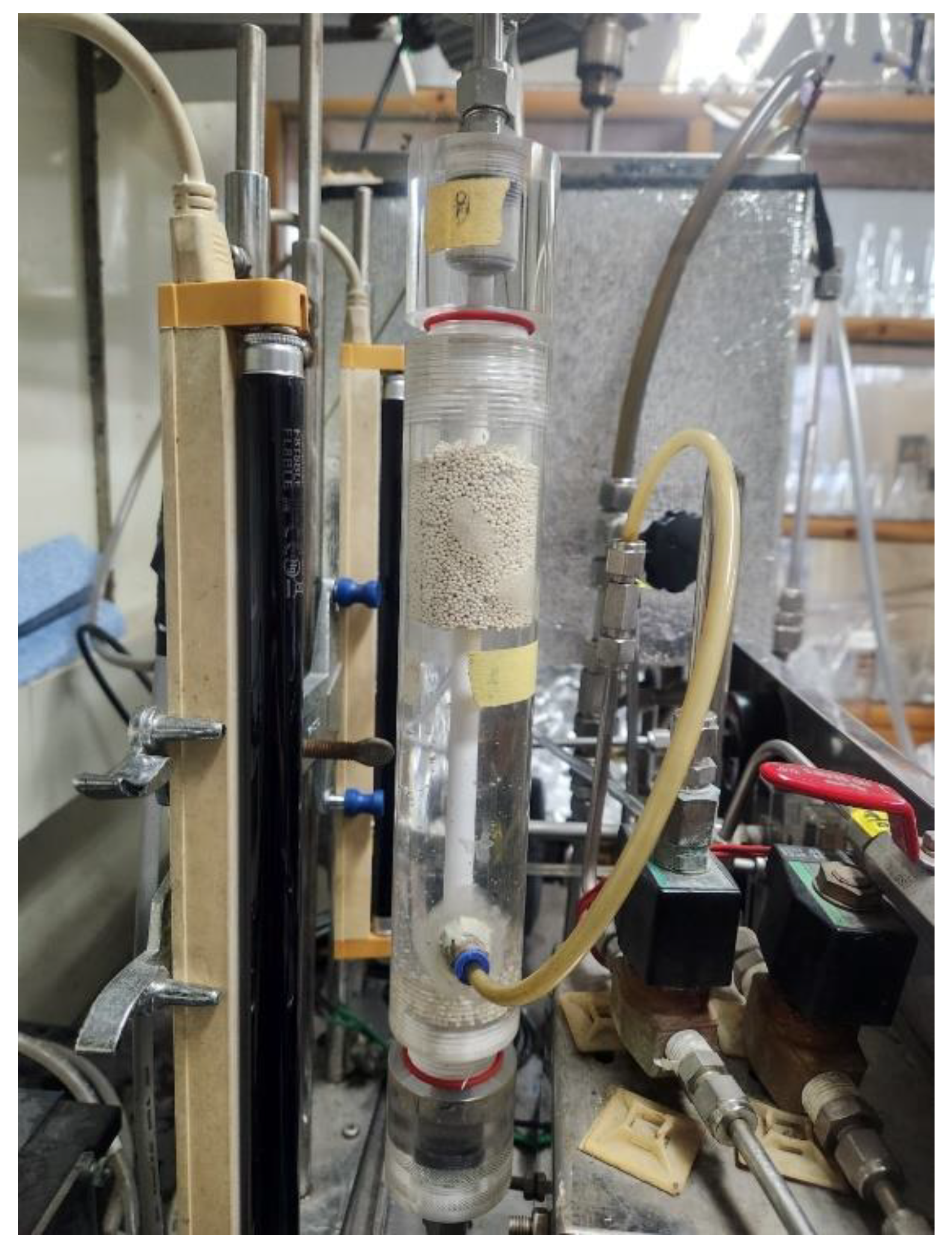
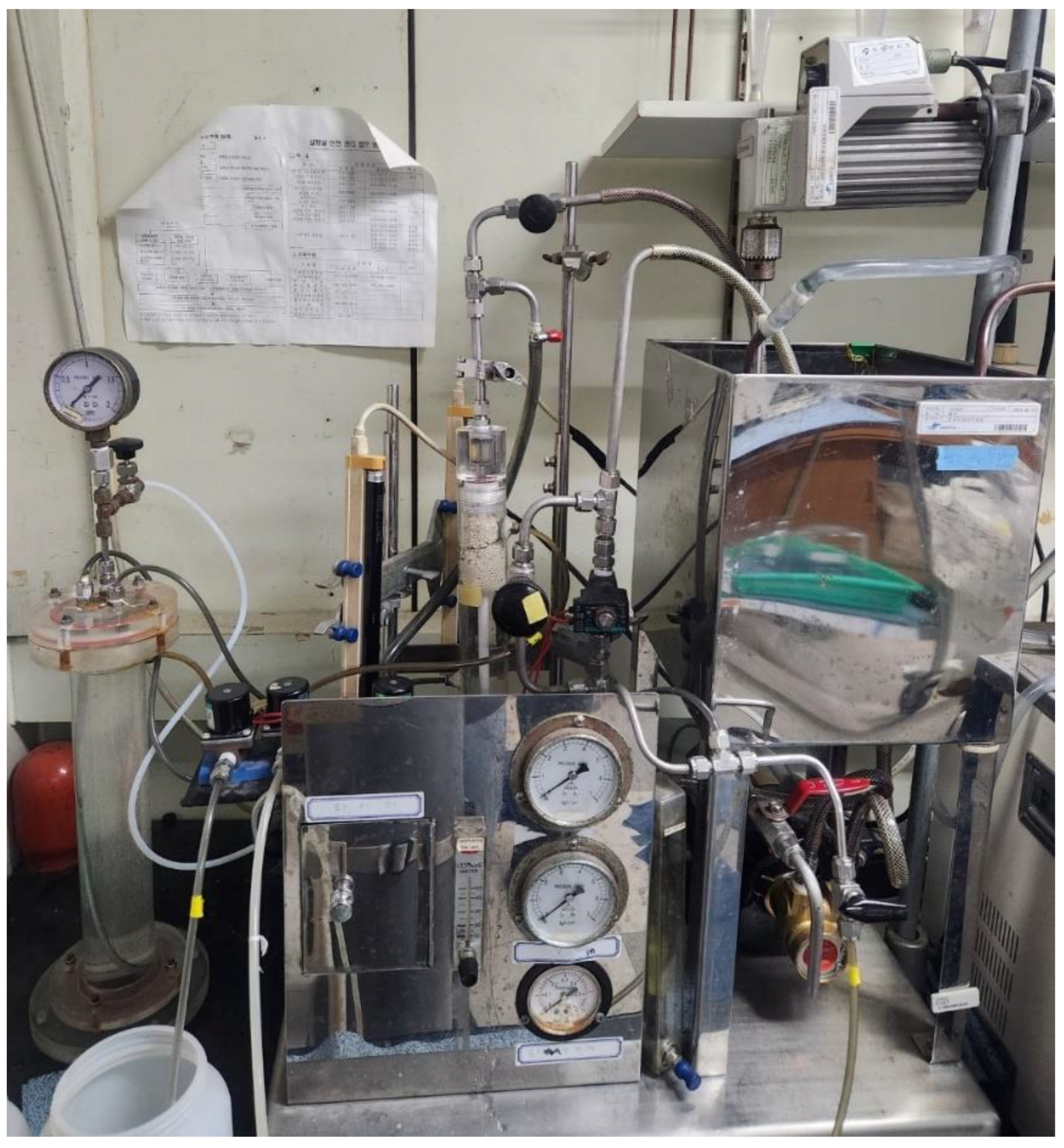
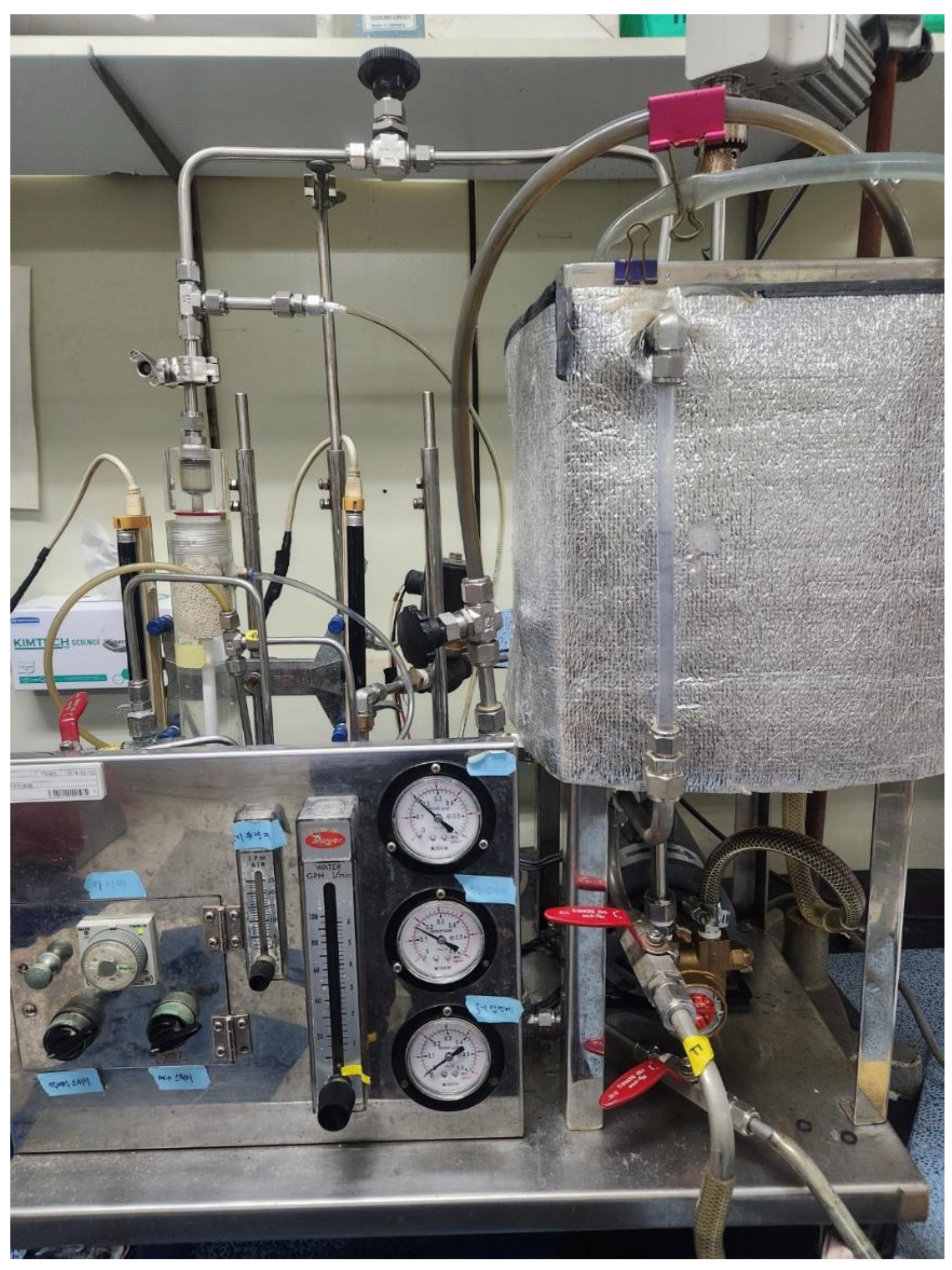
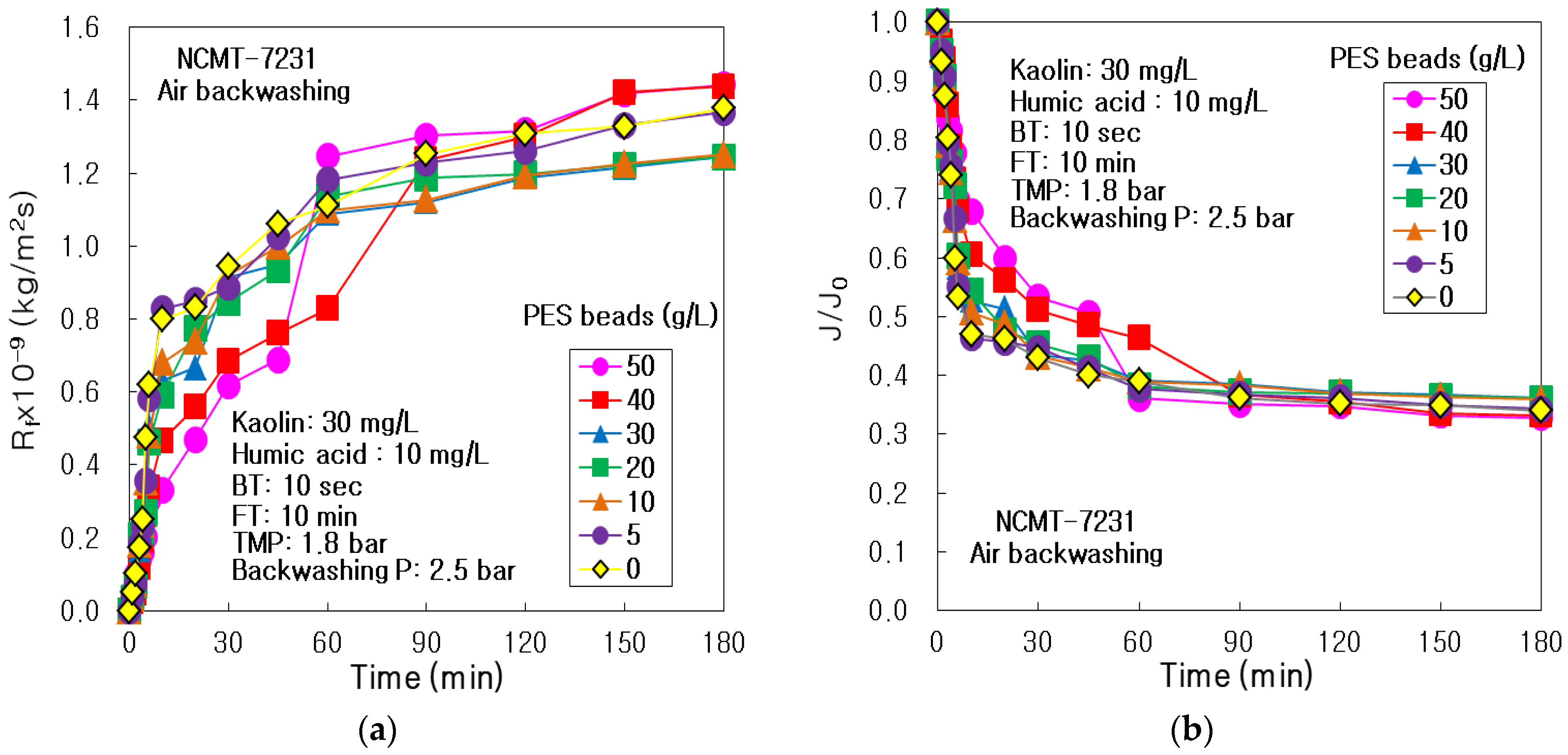




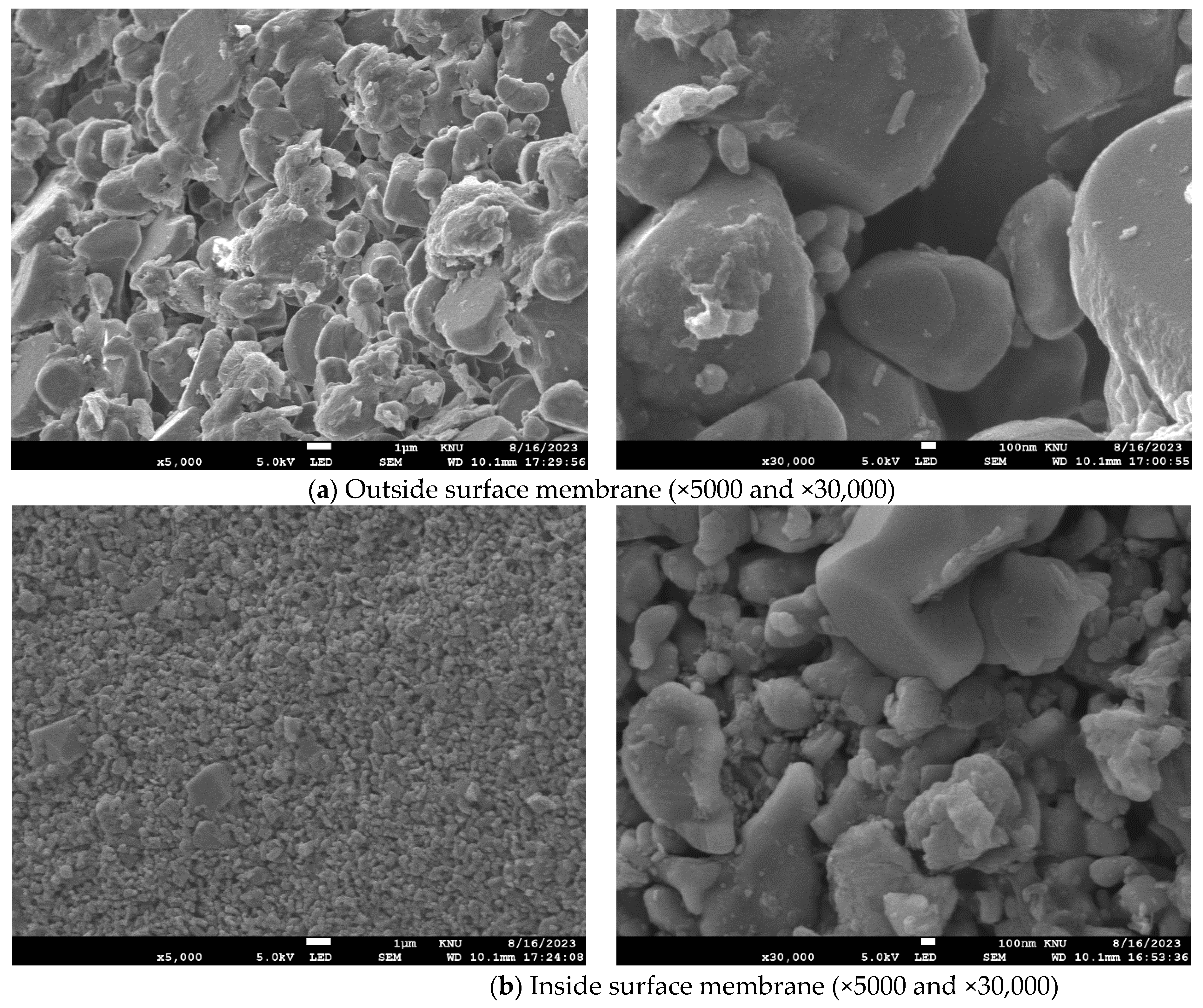
| Membrane Model | NCMT-7231 |
|---|---|
| Pore size (μm) | 0.4 |
| No. of channels | 1 |
| Outer diameter (mm) | 8 |
| Inner diameter (mm) | 6 |
| Length (mm) | 254 |
| Surface area (cm2) | 47.9 |
| Material | ⍺-alumina |
| Company | Nanopore Inc. (Cheonan, Republic of Korea) |
| Material of the beads | Polyethersulfone (PES) |
| TiO2 coating method | Phase inversion |
| Diameter (mm) | 1.4–1.8 |
| Weight (mg) | 1.3–1.8 |
| Average weight (mg) | 1.5 |
| PES Bead (g/L) | 50 | 40 | 30 | 20 | 10 | 5 | 0 |
|---|---|---|---|---|---|---|---|
| Rm × 10−9 (kg/m2s) | 0.694 | 0.701 | 0.695 | 0.700 | 0.695 | 0.694 | 0.699 |
| Rb × 10−9 (kg/m2s) | 0.011 | 0.016 | 0.008 | 0.003 | 0.007 | 0.021 | 0.012 |
| Rf,180 × 10−9 (kg/m2s) | 1.443 | 1.438 | 1.245 | 1.245 | 1.251 | 1.367 | 1.378 |
| Rif × 10−9 (kg/m2s) | 0.062 | 0.058 | 0.070 | 0.085 | 0.083 | 0.133 | 0.153 |
| Rrf × 10−9 (kg/m2s) | 1.381 | 1.380 | 1.175 | 1.161 | 1.167 | 1.233 | 1.225 |
| J0 (L/m2h) | 902 | 887 | 903 | 904 | 905 | 888 | 893 |
| J180 (L/m2h) | 296 | 295 | 326 | 326 | 325 | 305 | 304 |
| J180/J0 | 0.328 | 0.332 | 0.361 | 0.361 | 0.359 | 0.344 | 0.340 |
| VT (L) | 7.03 | 7.06 | 6.96 | 6.91 | 6.89 | 6.56 | 6.53 |
| PES Bead (g/L) | Turbidity (NTU) | Average Treatment Effectiveness (%) | |||
|---|---|---|---|---|---|
| Feed Water | Treated Water | ||||
| Scope | Average | Scope | Average | ||
| 50 | 35.2~37.6 | 36.8 | 0.283~0.374 | 0.312 | 99.2 |
| 40 | 35.8~37.4 | 36.8 | 0.358~0.638 | 0.480 | 98.7 |
| 30 | 34.4~36.8 | 35.6 | 1.009~1.332 | 1.119 | 96.9 |
| 20 | 35.2~37.4 | 36.5 | 0.776~1.033 | 0.909 | 97.5 |
| 10 | 36.1~37.1 | 36.6 | 0.978~1.351 | 1.179 | 96.8 |
| 5 | 35.4~37.3 | 36.6 | 1.429~1.715 | 1.586 | 95.7 |
| 0 | 35.8~37.1 | 36.5 | 1.853~2.384 | 2.099 | 94.2 |
| PES Bead (g/L) | UV254 Absorbance (cm−1) | Average Treatment Effectiveness (%) | |||
|---|---|---|---|---|---|
| Feed Water | Treated Water | ||||
| Scope | Average | Scope | Average | ||
| 50 | 0.251~0.274 | 0.265 | 0.021~0.061 | 0.037 | 86.0 |
| 40 | 0.253~0.271 | 0.264 | 0.021~0.051 | 0.038 | 85.6 |
| 30 | 0.258~0.281 | 0.267 | 0.036~0.071 | 0.053 | 80.3 |
| 20 | 0.253~0.276 | 0.263 | 0.029~0.081 | 0.058 | 78.0 |
| 10 | 0.259~0.277 | 0.268 | 0.032~0.103 | 0.069 | 74.3 |
| 5 | 0.258~0.278 | 0.266 | 0.036~0.103 | 0.078 | 70.7 |
| 0 | 0.253~0.271 | 0.263 | 0.076~0.105 | 0.088 | 66.2 |
| PES Bead (g/L) | 50 | 40 | 30 | 20 | 10 | 5 | 0 |
|---|---|---|---|---|---|---|---|
| Rm × 10−9 (kg/m2s) | 0.493 | 0.486 | 0.497 | 0.488 | 0.492 | 0.491 | 0.509 |
| Rb × 10−9 (kg/m2s) | 0.005 | 0.010 | 0.005 | 0.007 | 0.011 | 0.011 | 0.015 |
| Rf,180 × 10−9 (kg/m2s) | 5.113 | 4.862 | 4.926 | 4.945 | 4.967 | 4.985 | 5.151 |
| Rif × 10−9 (kg/m2s) | 0.244 | 0.213 | 0.248 | 0.228 | 0.200 | 0.199 | 0.209 |
| Rrf × 10−9 (kg/m2s) | 4.869 | 4.649 | 4.678 | 4.717 | 4.767 | 4.786 | 4.942 |
| J0 (L/m2h) | 1275 | 1278 | 1264 | 1282 | 1263 | 1263 | 1213 |
| J180 (L/m2h) | 113 | 119 | 117 | 117 | 116 | 116 | 112 |
| J180/J0 | 0.0888 | 0.0927 | 0.0926 | 0.0910 | 0.0919 | 0.0916 | 0.0922 |
| VT (L) | 2.57 | 2.67 | 2.65 | 2.64 | 2.63 | 2.60 | 2.58 |
| PES Bead (g/L) | Turbidity (NTU) | Average Treatment Effectiveness (%) | |||
|---|---|---|---|---|---|
| Feed Water | Treated Water | ||||
| Scope | Average | Scope | Average | ||
| 50 | 33.5~34.3 | 33.9 | 0.620~0.708 | 0.664 | 98.0 |
| 40 | 33.4~34.7 | 34.1 | 0.592~0.688 | 0.638 | 98.1 |
| 30 | 35.2~36.2 | 35.7 | 0.652~0.758 | 0.706 | 98.0 |
| 20 | 35.2~36.1 | 35.7 | 0.692~0.758 | 0.722 | 98.0 |
| 10 | 34.0~35.1 | 34.6 | 0.687~0.762 | 0.722 | 97.9 |
| 5 | 33.8~35.9 | 34.8 | 0.654~0.786 | 0.707 | 98.0 |
| 0 | 35.4~37.2 | 36.3 | 0.689~0.839 | 0.758 | 97.9 |
| PES Bead (g/L) | UV254 Absorbance (cm−1) | Average Treatment Effectiveness (%) | |||
|---|---|---|---|---|---|
| Feed Water | Treated Water | ||||
| Scope | Average | Scope | Average | ||
| 50 | 0.257~0.265 | 0.261 | 0.042~0.050 | 0.046 | 82.3 |
| 40 | 0.250~0.261 | 0.256 | 0.038~0.048 | 0.044 | 83.0 |
| 30 | 0.262~0.271 | 0.266 | 0.048~0.057 | 0.053 | 80.3 |
| 20 | 0.256~0.265 | 0.260 | 0.050~0.059 | 0.054 | 79.2 |
| 10 | 0.253~0.266 | 0.260 | 0.050~0.060 | 0.055 | 79.0 |
| 5 | 0.251~0.264 | 0.258 | 0.047~0.060 | 0.055 | 78.9 |
| 0 | 0.255~0.266 | 0.260 | 0.052~0.061 | 0.058 | 77.8 |
Disclaimer/Publisher’s Note: The statements, opinions and data contained in all publications are solely those of the individual author(s) and contributor(s) and not of MDPI and/or the editor(s). MDPI and/or the editor(s) disclaim responsibility for any injury to people or property resulting from any ideas, methods, instructions or products referred to in the content. |
© 2023 by the authors. Licensee MDPI, Basel, Switzerland. This article is an open access article distributed under the terms and conditions of the Creative Commons Attribution (CC BY) license (https://creativecommons.org/licenses/by/4.0/).
Share and Cite
Hong, S.; Park, S.; Park, J.Y. Role of Titanium Dioxide-Immobilized PES Beads in a Combined Water Treatment System of Tubular Alumina Microfiltration and PES Beads. Membranes 2023, 13, 757. https://doi.org/10.3390/membranes13090757
Hong S, Park S, Park JY. Role of Titanium Dioxide-Immobilized PES Beads in a Combined Water Treatment System of Tubular Alumina Microfiltration and PES Beads. Membranes. 2023; 13(9):757. https://doi.org/10.3390/membranes13090757
Chicago/Turabian StyleHong, Sungtaek, Sungwoo Park, and Jin Yong Park. 2023. "Role of Titanium Dioxide-Immobilized PES Beads in a Combined Water Treatment System of Tubular Alumina Microfiltration and PES Beads" Membranes 13, no. 9: 757. https://doi.org/10.3390/membranes13090757
APA StyleHong, S., Park, S., & Park, J. Y. (2023). Role of Titanium Dioxide-Immobilized PES Beads in a Combined Water Treatment System of Tubular Alumina Microfiltration and PES Beads. Membranes, 13(9), 757. https://doi.org/10.3390/membranes13090757








